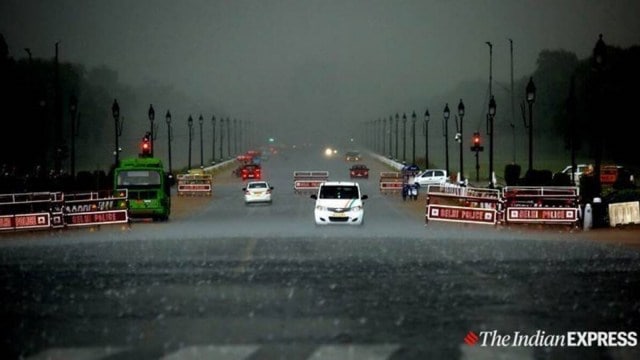Five flights diverted, traffic congestion in many places as rain lashes Delhi after days of sweltering heat
The downpour brought about a dip in mercury, with the maximum temperature settling at 34.2°Celsius, three degrees below the previous day’s figure. The minimum temperature was 28.7°C, five degrees below normal.
 The probability forecast maps by the IMD, meanwhile, indicate hotter nights and colder days in Delhi during October. “There will be a fall in both minimum and maximum temperatures in the Northwest after the low-pressure system weakens,” said Mohapatra.
The probability forecast maps by the IMD, meanwhile, indicate hotter nights and colder days in Delhi during October. “There will be a fall in both minimum and maximum temperatures in the Northwest after the low-pressure system weakens,” said Mohapatra.
After days of sweltering heat, Delhi was swept by a sudden spell of heavy rain that disrupted flights, slowed down traffic, and dampened festival preparations across the city on Tuesday afternoon.
The downpour, though, brought about a dip in mercury, with the maximum temperature settling at 34.2°Celsius, three degrees below the previous day’s figure. The minimum temperature was 28.7°C, five degrees below normal. Overall, in September, the city recorded the second lowest monthly average minimum temperature (24.6°C) since 2018. In 2024, the figure stood at 24.6°C.
Sources at the Indira Gandhi International Airport said that due to adverse weather conditions in the Capital, five flights were diverted to Jaipur between 12.15 and 12.30pm.
Indigo posted on X: “There’s a heavy downpour over #Delhi at the moment, causing some temporary disruption to flight schedules. If you’re travelling today, please be aware of potential delays and allow additional time for your journey, especially with traffic moving slower than usual.”
Air India also advised passengers to check their flight status before heading to the airport and to allow extra time for road travel.
As the rainfall continued, waterlogging was reported and traffic advisory issued for Zakhira Railway underpass. Other areas that saw waterlogging were ITO, Vikas Marg, Minto Road underpass and Mayur Vihar.
A few Ravana effigies being prepared for Dussehra celebrations at Ramlila Maidan also got dampened in the rain, sources said.
Safdarjung, which is Delhi’s base weather station, logged 37.8 mm rainfall, as per the India Meteorological Department (IMD). Ayanagar saw the highest rainfall with 72.6 mm, followed by Ridge 52.9 mm, Janakpuri 47 mm, Mayur Vihar 35 mm and Lodi Road 29.8 mm.
On the cause for Tuesday’s sudden downpour, Krishna Mishra, a senior IMD scientist, said, “An intense low-pressure area lies over Gulf of Kutch. The trough (an elongated low-pressure area) reaches Southeast Uttar Pradesh. Another trough runs from this well-marked low pressure area to Northwest Rajasthan in lower tropospheric levels. The rainfall may be attributed to these two troughs facilitating moisture supply from both Arabian Sea and the Bay of Bengal.”
Earlier in the day, the IMD had issued an orange alert for the Capital, warning of moderate rain or thunderstorms with gusty winds reaching up to 40 kmph.
For the week ahead, the IMD has forecast light rain or drizzle on Wednesday with partly cloudy skies on most days. Light rain or drizzle is again forecast on October 6 and maximum temperatures are expected to settle between 32°C and 34°C, which is slightly below the season’s normal. The minimum temperatures will be above normal by 3-4°C in Northwest India till October 4, said the IMD.
Delhi recorded seven rainy days this September, with total rainfall at 173.9 mm — 40% above the seasonal normal of 123.5 mm.
In a major relief from the sweltering temperatures recorded earlier this week, the IMD forecast has indicated that southeasterly winds are expected to persist through the week, keeping temperatures in check.
Unlike the dry northwesterlies that carry dust and smoke from crop- burning in Punjab and Haryana, these easterly winds bring in moisture but not pollution.
Meanwhile, in the last 15 days, 155 crop-burning events have been reported with 95 such cases in Punjab, seven in Haryana, 42 in Uttar Pradesh, two in Rajasthan and nine in Madhya Pradesh, as per the Indian Agricultural Research Institute.
For Delhi’s air quality, the rain and wind shift may bring some relief, as after nearly three weeks of “moderate” AQI levels above 100, the showers are likely to help wash out pollutants and offer residents their first respite from the city’s poor air quality. Delhi’s AQI on Tuesday was 117, in the moderate category – a marginal dip from Monday’s 120.
In October, Delhi, among other regions of Northwest India, could see reduced rainfall activity, which is normal for the season. “Forecasts from the Monsoon Mission Coupled Forecast System (MMCFS) and other climate models suggest an increased likelihood of La Niña conditions developing during the post-monsoon season,” the IMD has said. La Niña generally causes extreme weather events and results in cooler-than-average ocean temperatures in the eastern Pacific, known to be helping monsoon activity and thereby impacting temperatures.
“La Niña conditions would not be long-lasting as they will give way to neutral conditions,” said IMD Director General, Mrutyunjaya Mohapatra. He said it was too early to confirm whether Delhi could see a harsher winter.
The probability forecast maps by the IMD, meanwhile, indicate hotter nights and colder days in Delhi during October. “There will be a fall in both minimum and maximum temperatures in the Northwest after the low-pressure system weakens,” said Mohapatra.







